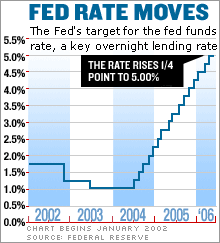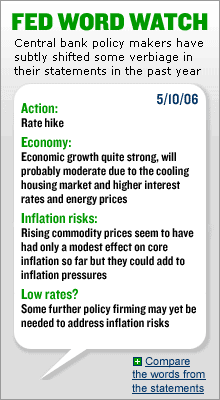Fed walks fine line Investors want Bernanke & Co. to signal a pause, but also want assurance that the central bank has inflation under control. NEW YORK (CNNMoney.com) -- Investors would love it if the Federal Reserve provided a roadmap for interest rates in the coming months after this week's two-day meeting. But chances are the Fed will leave the market guessing about what's next. When Ben Bernanke took the helm at the Federal Reserve from Alan Greenspan in February, many had expected him to raise rates just once before pausing, which would have left the central bank's key short-term rate at 4.75 percent.
But now financial markets aren't sure when the Fed will wind down its two-year old rate hiking campaign, so investors will be watching closely to see what the Fed says in its statement. The central bank has an especially tough job on its hands, economists and market strategists say. Investors are nervous about rising inflationary pressures just as the economy looks set to slow. And financial markets are also still coming to terms with Bernanke, who will chair only his third policy meeting next week. It's all but certain the central bank's policy-makers will raise their short-term rate target for the 17th straight time Thursday by a quarter of a percentage point, to 5.25 percent. Some traders are even laying small odds - about a 10 percent chance - that the Fed will raise rates half a point next week. Since the Fed's last rate increase in May, stock markets at home and abroad have been roiled by uncertainty regarding the prospect of further rate hikes this year. "If there isn't greater clarification about the Fed's intentions," the markets will be left guessing all summer, said Eugene Peroni, senior managing director at Claymore Advisors, a money management firm. Inflation watch Many expect the central bankers to keep up their drumbeat of concern about inflation in their statement. Fed officials have talked tough on inflation since the May meeting, and the latest consumer price report, which showed growing inflation pressures, cemented expectations for at least two more rate hikes this year. Interest rate futures are pricing in a 90 percent chance of another quarter-point hike at the Fed's August meeting. "We think they will express more concern about inflation pressures in the statement and will signal that some further policy firming may be needed," said Dean Maki, chief U.S. economist at Barclays Capital. "Further policy firming" has been interpreted by the market as Fed-speak for more quarter-point rate hikes. Investors are also hoping for more clarity from the Fed. Some complain that Bernanke has given mixed messages. In April he told Congress the Fed might pause but followed up a few days later by saying financial markets had misread him as too dovish on inflation. "What's important is that the Fed leaves this meeting with enough latitude to make another rate increase a realistic threat," Ken Kam, CEO and portfolio manager at Marketocracy, said. "They want to be regarded as vigilant on inflation." At the same time, the Fed wants to give itself flexibility as it tries to navigate a soft landing for the economy. In the statement from May's meeting, policy-makers left the door open for a pause but suggested they may not stop raising rates completely. They also said they'd be watching the economic numbers, just like everyone else. (Read the full statement.) "They can continue to use the same language. I think we'll still be in data dependent mode," said Jane Caron, chief economic strategist at Dwight Asset Management. Tough task But some economists are worried the Fed will keep hiking rates well past June. Caron said the economy could handle a fed funds rate as high as 5.5 percent, but the Fed risks overshooting and choking off economic growth if it goes much past that. The fed funds rate affects rates on auto loans, credit cards and on various corporate loans. Pushing rates too high could slow borrowing and send the economy into a slowdown. And some economists say the Fed has tended to go too far when winding down prior rate-hiking cycles. Josh Stiles, a bond strategist with research firm IDEAglobal, said he doesn't think the Fed will make this mistake again. He thinks policy-makers may pause in August, but that they won't express that sentiment explicitly next week. "I think the Fed will be looking for reasons to make the case for pausing but they don't want to spell it out in the statement," he said. Policy-makers could emphasize some recent indications of economic weakness to signal it may soon pause. The past two monthly employment numbers have been disappointing, the housing sector looks to be cooling and consumer spending growth has slowed. In addition, short-term Treasury rates have recently climbed back above long-term interest rates - a so-called inverted yield curve that is widely considered a sign of a slowing economy, and even a possible recession. (Full story.) And even if the Fed keeps raising to ward off inflation, some economists say its ability to combat rising price pressures through rate hikes is limited. (Full story.) Instead, the central bank could pause and let a slowdown ease inflation risks, according to Ken Mayland, president of ClearView Economics, a firm specializing in economic research and forecasting. Yet, if the Fed takes its foot off the brake, it risks losing credibility on the inflation front. "This is the dilemma the Fed faces. Somehow the Fed's got to reassure the markets that they're watching inflation but that the upcoming slowdown in the economy will curb those pressures," Mayland said. Related: Rate hike survival guide Related: Special report: Fed Focus |
| ||||||||||||


